AI technology has made remarkable strides in various industries, and the fashion world is no exception. In recent years, a new phenomenon has emerged – AI-generated fashion models. These computer-generated virtual models are revolutionizing how fashion brands and designers approach their marketing campaigns and advertisements. In this article, we will introduce the best 6 AI fashion model generators.
#1 VirtuLook
VirtuLook is an AI product photo generator that utilizes advanced AI technology to provide users with an efficient and convenient way to generate high-quality product photos. VirtuLook can create realistic, high-resolution virtual model images based on individuals' style preferences and body shapes. Users can easily visualize their clothing creations, try out different looks, and bring designs to life without the need for expensive photography shoots or physical prototypes.
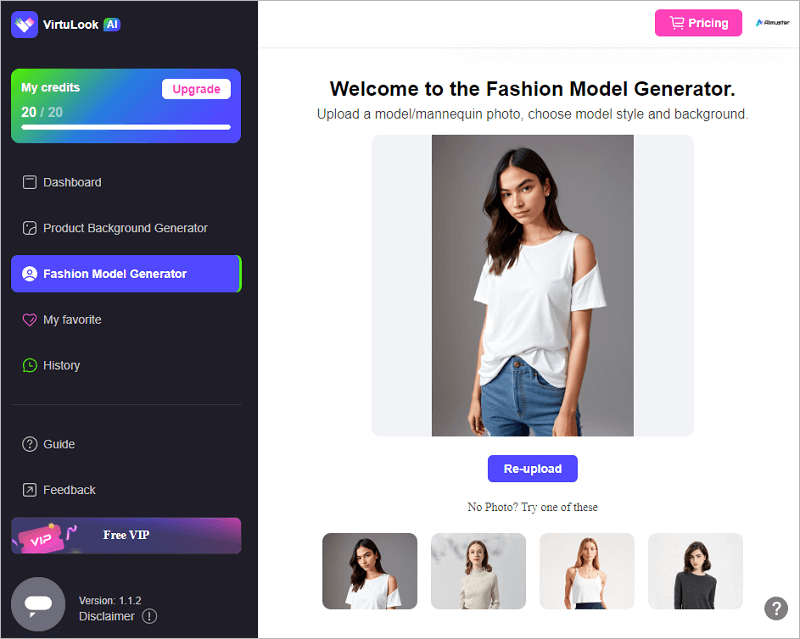
Key Features
- Virtual model fitting: Users can showcase as many clothes on as many bodies as possible.
- AI-generated backgrounds: Create engaging product backgrounds without extensive design skills.
- Diverse products, dynamic images: Ensure each generated image reflects the essence and quality of the product, enhancing appeal to potential customers.
- More photos based on text input: Get 10 times more photos with just text input.
- Efficient workflow: Streamlined workflow saves 100% of the time.
- Advanced AI algorithms: Boost ecommerce conversion rates by 90% with advanced AI algorithms.
Pros
- Can create lifelike virtual models that fit your products seamlessly.
- An AI-driven background generator that eliminates the need for intricate design skills.
- With a simple text input, you can receive a staggering 10 times more images based on the provided descriptions.
- VirtuLook's workflow is efficient and easy to use.
- Can generate diverse product images using cutting-edge AI algorithms.
Cons
- VirtuLook is primarily focused on business and product photography.
- Full functionality requires payment.
#2 OnModel
OnModel.ai is an artificial intelligence tool developed by Trendage specifically for fashion ecommerce, allowing stores to instantly switch models in product photos. Its goal is to enhance customer engagement and improve SEO. OnModel.ai helps merchants increase sales by upgrading product photos with AI fashion models, while avoiding negative SEO impacts from using the same images as other stores. Additionally, it fosters connection with customers by showcasing diversity in models' race and skin color.
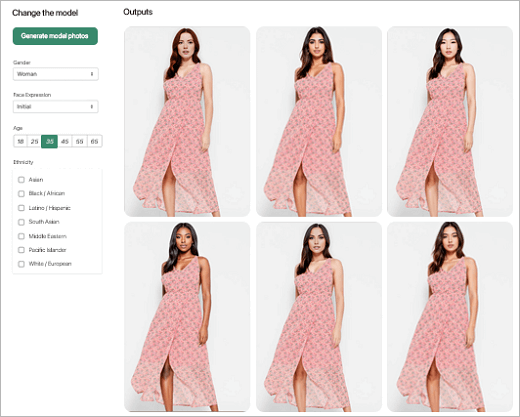
Key Features
- Model replacement: Swap models based on gender, race, age, expression, makeup, etc.
- Background replacement: Easily remove and change image backgrounds for store standardization.
- Facial generation for cropped images: Magically reveal faces even when images are cropped and headless.
- Batch replace all images: Run batch jobs to generate thousands of images for the entire store.
- Photo upgrades: Instantly improve photos by upgrading models, backgrounds, etc., without changing clothes.
Pros
- Ease of use.
- Fast and responsive customer service.
- Cost-effective solution for creating marketing photos.
- Constantly improving with new features.
Cons
- Models may appear too artificial to some users.
- Issues with details like fingers.
- Some users find it incompatible with their products.
#3 Lalaland
Lalaland.ai is an AI-based digital model studio designed for digital designers. Integrated closely with Browzwear VStitcher, Lalaland.ai allows you to showcase 3D designs on its leading generative AI models. You can create unique avatars in under 5 minutes, customizing hair, body shape, skin tone, etc., to reflect your target audience. Additionally, you can select different poses, emotions, and other features to enhance the overall image.
These AI-generated models, inspired by real individuals, serve as a "single authentic source" between creative designers, product managers, buyers, and retailers. Lalaland.ai allows you to showcase your clothing on different types of models, establishing an inclusive brand image.
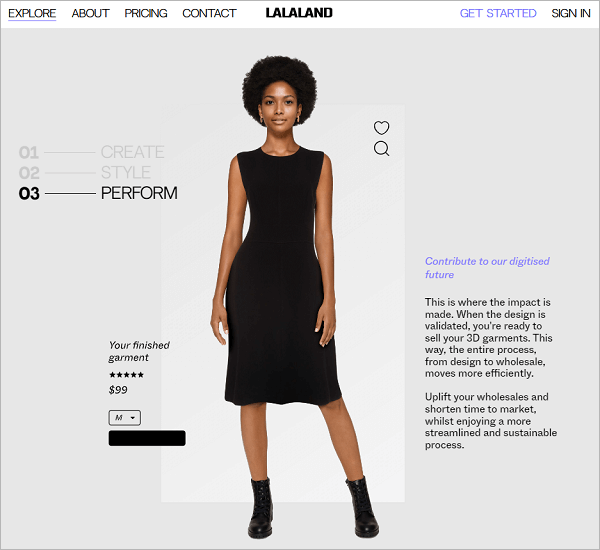
Key Features
- Customization: Customize each avatar, including hairstyle, body shape and size, skin color, etc.
- Pose and emotion selection: Choose from a range of poses, emotions, and other features to enhance the overall image.
- Add clothing: Add 3D-designed clothing to avatars.
- 3D model validation: Validate and enrich your 3D designs with realistic model verification before production.
Pros
- High-quality results.
- Easy to use.
- Fast processing.
- Customize individual avatars.
- Reasonable pricing.
Cons
- Requires additional learning for designers not using VStitcher.
- While realistic, AI-generated models may not completely replace real-life fitting experiences.
#4 Botika
Botika is a platform providing AI-generated models for fashion ecommerce. Leveraging the power of generative AI, it helps online fashion stores enhance their business and brand. By introducing AI-generated models and generating endless professional fashion photos, Botika empowers retailers to better engage with customers, enter new markets effortlessly, and increase conversion rates.
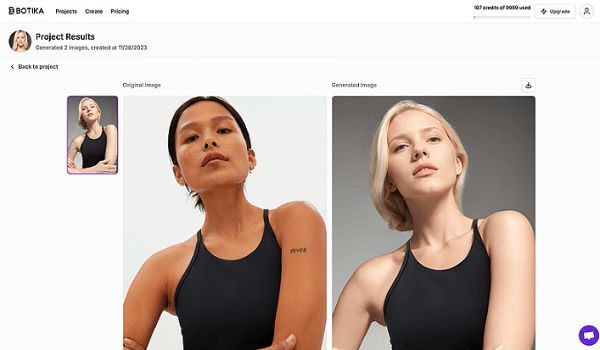
Key Features
- Automatically upgrade your current on-model photos and turn them into an infinite selection of professional product images.
- Use your existing on-model images, upload any angle or pose, even headless photos.
- Select the best models for your products from Botika's diverse AI-generated model library.
- Easily switch backgrounds and create lifestyle photos.
- Transform your everyday photos into beautiful product images your customers will love.
Pros
- Capable of generating high-quality fashion product images.
- Very intuitive interface design.
Cons
- Botika's AI-generated model library may not meet some users' specific needs.
- Pricing might be high for some small businesses or individual users.
#5 Resleeve
Veesual specializes in creating virtual try-on experiences for fashion ecommerce. Their tool allows shoppers to try on any clothing they like and see it on a model they identify with. The aim is to create an inclusive experience through the power of imagery, enabling everyone to participate.
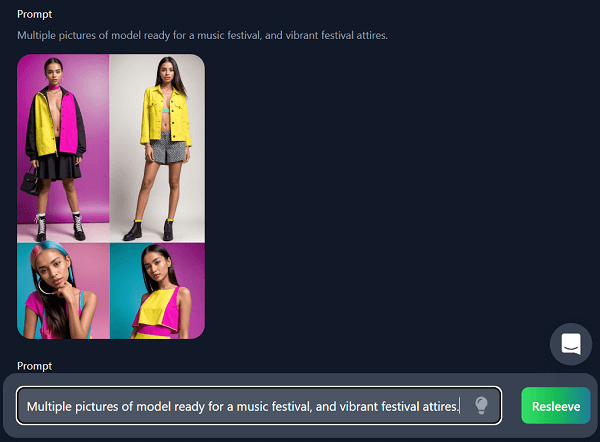
Key Features
- Generate thousands of realistic AI fashion designs in seconds.
- Professional AI fashion photography in minutes.
- Cost and time efficiency by reducing expenses and accelerating time to market.
- Showcase your clothing in real-life scenarios without hiring models or setting up complex props; just one input image can display your apparel in real-life settings.
Pros
- Instant design generation.
- Effortless photoshoots.
- Cost and time efficiency.
- Realistic fashion showcases.
Cons
- While AI can generate designs quickly, the quality of these designs might not always meet high standards or specific user requirements.
#6 Veesual
VirtuLook is an AI product photo generator that utilizes advanced AI technology to provide users with an efficient and convenient way to generate high-quality product photos. VirtuLook can create realistic, high-resolution virtual model images based on individuals' style preferences and body shapes. Users can easily visualize their clothing creations, try out different looks, and bring designs to life without the need for expensive photography shoots or physical prototypes.
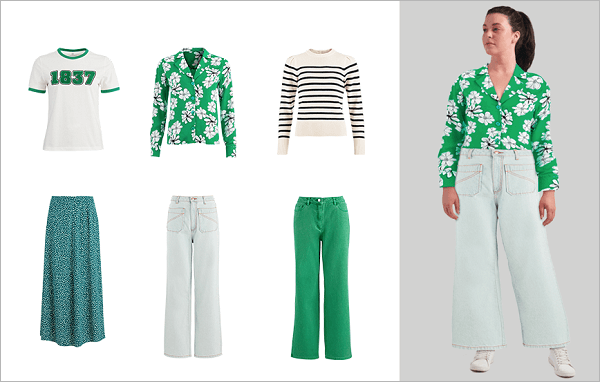
Key Features
- Users can mix and match their favorite clothing and select their preferred models.
- Enhanced ecommerce experience allowing online shoppers to virtually try on clothes.
- No need for 3D models.
- Seamless integration with any CMS.
Pros
- Helps users quickly create and modify virtual try-on experiences, thereby increasing workflow efficiency.
- No need for 3D models reduces barriers to use.
- Seamless integration with any CMS makes it easy for users.
Cons
- Virtual try-on effects may differ from real-life results.
- May lack accuracy when handling complex patterns or clothing styles.
Conclusion
AI-generated fashion models are reshaping the industry by providing cost-effective, efficient, and visually appealing solutions. Whether it's VirtuLook's lifelike models, OnModel's accurate fitting, or Lalaland's personalized experiences, these tools offer exciting possibilities for fashion brands. As technology continues to evolve, we can expect even more innovative solutions in the world of AI fashion modeling.




